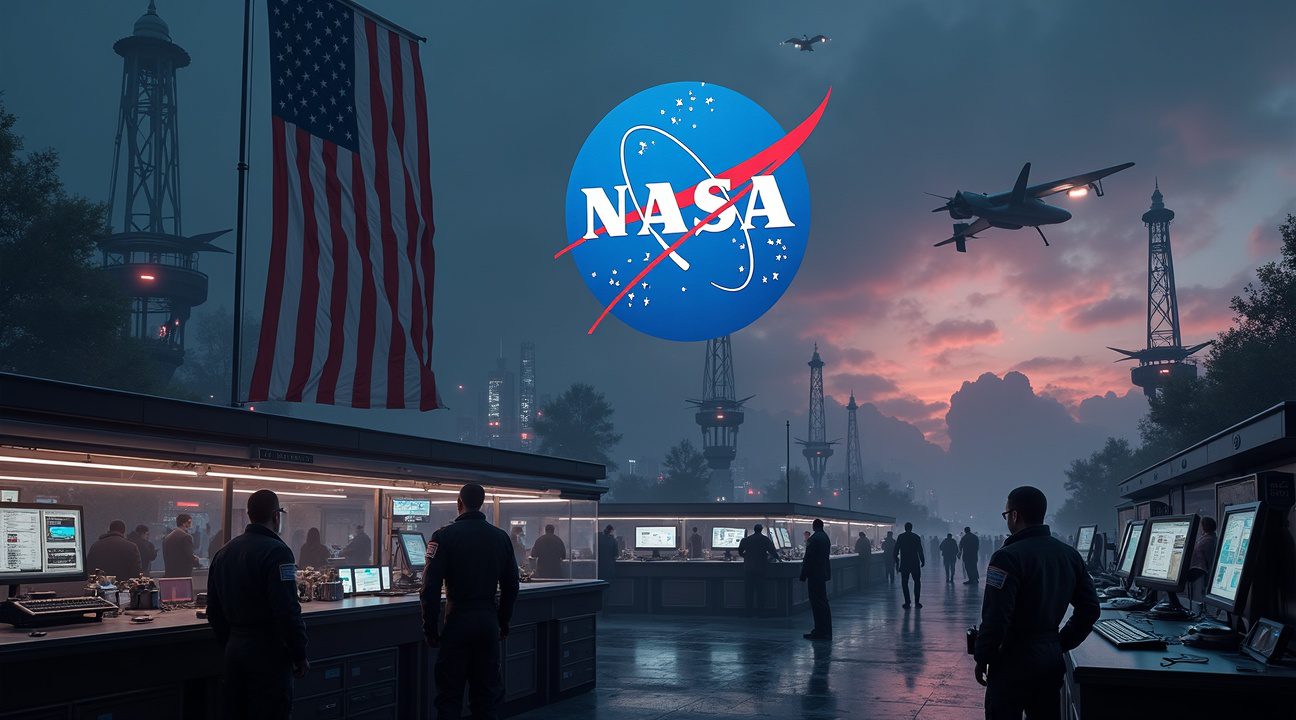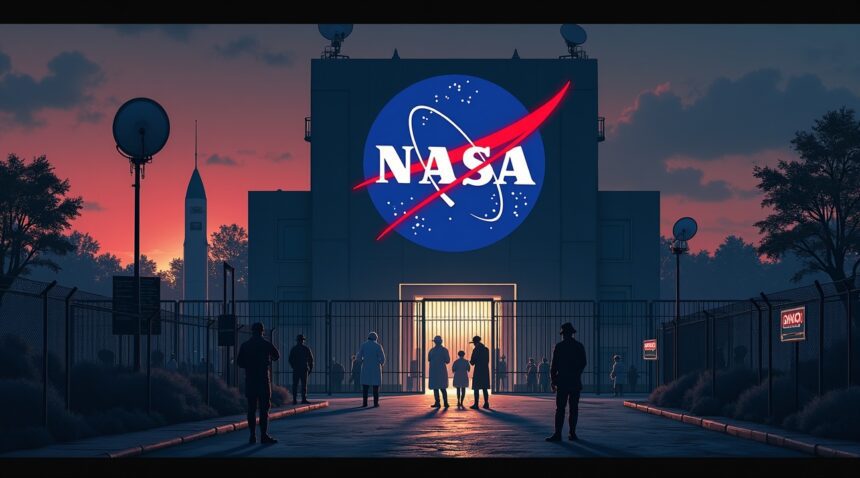President Trump’s August 2025 Executive Order has sparked sweeping changes to NASA, redefining the agency’s core mission and threatening its longstanding scientific contributions amid a pivot toward privatized space exploration.
Transformation of NASA’s Role
Under the new directive, NASA has been formally reclassified as an intelligence organization. This monumental shift effectively ends the institution’s 67-year role as a civilian space agency. As a result, thousands of its employees have lost their federal labor protections and collective bargaining rights, sparking concern among unions and scientific communities.
Impact on Workforce
The restructuring threatens deep workforce reductions. Approximately one-third of NASA’s employees—scientists, engineers, and support staff—are at risk of layoffs. This mass departure would represent a significant loss of expertise that is not easily replaceable in a high-skill field like space science and engineering.
Devastating Budget Cuts
Alongside the agency’s reclassification, the proposed 2026 fiscal budget includes a staggering 25% cut to NASA’s overall funding, amounting to a loss of $6.1 billion. These financial reductions will have immediate and far-reaching effects across multiple programs.
Science Programs in Jeopardy
Key areas facing severe reductions include:
- Science programs experiencing a 47% funding cut, threatening ongoing planetary and astrophysical research
- Earth Science initiatives losing 53% of their current budget, which could compromise climate monitoring and environmental data collection
Termination of Space Missions
At least 41 active missions are now at risk of immediate cancellation, including:
- Chandra X-ray Observatory — a cornerstone of NASA’s astrophysics program
- Earth observation satellites that have been capturing essential climate data for decades
Shifting Focus to Private Sector
This restructuring aligns closely with the administration’s broader policy to prioritize commercial space ventures. Regulatory changes accompanying this shift include expedited approvals through the FAA, bypassing many traditional environmental and administrative reviews.
Advantages for Commercial Entities
- Streamlined regulatory processes that allow private companies to launch more rapidly
- Exemptions from environmental reviews that eliminate obstacles for commercial development
- Limited government oversight reducing delays typically encountered in federal projects
This evolution marks a significant turning point, as America pivots from publicly-funded space exploration to a model emphasizing profit-driven, commercial-led expansion. For detailed updates on this development, readers can follow reporting from NASA or government policy trackers.
Trump Reclassifies NASA as Intelligence Agency in Unprecedented Executive Order
President Donald Trump’s August 2025 Executive Order fundamentally altered NASA’s institutional identity, transforming the space agency from its traditional civilian research mission into a primarily intelligence-focused organization. This dramatic shift places NASA alongside agencies like the Department of Energy and the U.S. Agency for Global Media, all now exempt from federal collective bargaining requirements under the new classification.
Breaking From Seven Decades of Civilian Space Exploration
The Executive Order represents the most significant restructuring of NASA since its establishment in 1958. Previously dedicated to peaceful space exploration and scientific advancement, the agency now operates under a national security mandate that prioritizes defense and intelligence objectives. This change affects everything from mission planning to personnel management, fundamentally altering how NASA conducts its operations.
Trump’s decision bypasses the Civil Service Reform Act of 1978, stripping NASA employees of traditional labor protections that federal workers have enjoyed for decades. Agency staff can no longer participate in collective bargaining, a move that mirrors restrictions placed on other intelligence and national security organizations. The reclassification effectively removes NASA from standard federal employment frameworks, giving administrators greater control over hiring, firing, and operational decisions.
Implications for Space Research and National Security
This policy shift signals a broader transformation in how the administration views space activities. Rather than focusing solely on scientific discovery and exploration, NASA’s new intelligence designation suggests increased emphasis on surveillance capabilities, military applications, and national security objectives. The change aligns with growing concerns about space-based threats and competition from other nations in critical space technologies.
The reclassification also impacts ongoing partnerships and collaborative projects. International space cooperation, historically a hallmark of NASA’s civilian mission, may face new restrictions under intelligence agency protocols. Projects like Saturn moon research and advanced propulsion trials could now operate under different security classifications and oversight requirements.
The Executive Order’s timing coincides with budget discussions that threaten significant cuts to space research funding. While the administration emphasizes national security priorities, traditional scientific missions face uncertain futures under the new framework. This creates tension between NASA’s expanded intelligence role and its reduced research capacity, potentially affecting long-term space exploration goals and scientific advancement initiatives.
Federal employees across NASA facilities now operate under different employment conditions, with union representatives expressing concerns about job security and workplace protections. The change affects thousands of scientists, engineers, and support staff who joined NASA expecting civilian agency benefits and protections.

NASA Faces Devastating 25% Budget Cut in 2026 Proposal
Trump’s proposed 2026 budget delivers a crushing blow to NASA’s operations, slashing the agency’s total funding from $24.9 billion to $18.8 billion. This dramatic reduction represents nearly 25% of NASA’s current budget and signals a fundamental shift in how the administration views space exploration priorities.
The science division bears the heaviest burden under this proposal, facing a catastrophic 47% budget reduction. This cut eliminates roughly one-third of all ongoing science missions across planetary exploration, astrophysics research, and Earth science projects. Scientists who have dedicated years to developing these missions now face the prospect of watching their work disappear overnight.
Earth Science Programs Hit Hardest
Earth science programs suffer the most severe cuts, with funding slashed by 53%. These programs have provided critical data on climate patterns, natural disasters, and environmental changes that affect millions of Americans. The reduction effectively ends NASA’s role as a leading provider of Earth observation data, forcing researchers to rely on international partners or private companies for essential information.
The human cost of these budget cuts extends far beyond canceled missions. Approximately one-third of NASA’s workforce faces potential layoffs, representing thousands of engineers, scientists, and support staff who have built their careers advancing space exploration. These job losses will ripple through communities surrounding NASA centers, affecting local economies that depend on the agency’s presence.
Private companies may benefit from this shift as SpaceX and other commercial ventures step in to fill gaps left by reduced NASA capabilities. However, the loss of institutional knowledge and scientific expertise cannot be easily replaced by private sector alternatives.
The timing of these cuts coincides with increasing international competition in space exploration. While NASA faces budget constraints, other nations continue investing heavily in their space programs. China’s rapid advancement in lunar exploration and planetary science missions positions them to surpass American capabilities in key areas.
Research institutions across the country will feel the impact as NASA-funded projects lose their financial backing. University partnerships that have driven innovation for decades may dissolve, leaving students and faculty without access to space-based research opportunities. The scientific community warns that rebuilding these capabilities could take decades and cost significantly more than maintaining current programs.
The proposed cuts also affect ambitious future missions already in development. Projects that promised to advance human understanding of the solar system and beyond now face cancellation, potentially setting back scientific discovery by years or decades.

41 Active Space Missions Face Immediate Termination
The proposed budget cuts threaten to halt at least 41 ongoing NASA space missions, creating unprecedented disruption across multiple scientific disciplines. These missions currently gather critical data from various corners of the Solar System, track cosmic phenomena, and monitor Earth’s changing environment in real-time.
Critical Programs on the Chopping Block
Several high-profile missions face immediate cancellation under the proposed cuts. The Apophis asteroid flyby mission stands among the threatened programs, despite its importance for planetary defense research. Earth Science satellites that monitor climate patterns, weather systems, and environmental changes would also lose funding, ending decades of continuous observation.
The Chandra X-ray Observatory represents one of the most significant losses on this list. This space telescope has supported over 10,000 scientific papers since its launch, making it one of the most productive scientific instruments ever deployed. Its termination would halt ongoing research into black holes, neutron stars, and other high-energy cosmic phenomena.
The Landsat program faces particularly devastating cuts, potentially ending an unbroken streak of Earth monitoring that began in 1972. This program has provided consistent satellite imagery for agriculture, urban planning, disaster response, and climate research for more than five decades. Scientists rely on this continuous dataset to track long-term environmental changes and predict future trends.
Additional missions spanning Solar System exploration, deep space observation, and Earth monitoring would cease operations. These include various planetary probes, atmospheric research satellites, and astronomical observatories that cost billions of dollars to develop and deploy.
The financial implications extend far beyond simple budget savings. Canceling these missions would waste billions in sunk research and development costs already invested over years or decades of planning and construction. Many spacecraft and instruments can’t simply be mothballed and restarted later – once terminated, these complex systems often can’t resume operations.
Scientists express particular concern about losing irreplaceable long-term datasets. Many research projects depend on continuous data collection spanning multiple years or decades to identify patterns and trends. Breaking these data records would compromise ongoing studies and limit future research capabilities.
The timing of these cuts coincides with several upcoming space exploration milestones and planned missions. This creates additional complications as international partnerships and collaborative research projects face uncertainty about continued American participation in joint ventures.
Several missions approaching critical phases of operation would halt just before delivering their most important scientific results. This represents not only wasted investment but also missed opportunities to advance human understanding of space and Earth systems during crucial periods of discovery.
American Science Leadership and Innovation at Risk
I’ve witnessed firsthand how NASA’s scientific endeavors have consistently driven technological breakthroughs that transform entire industries. Cutting the agency’s science funding threatens to undermine decades of American leadership in space exploration and technological innovation, creating ripple effects that extend far beyond government laboratories.
The Economic Impact of Research Funding Cuts
Budget reductions would force immediate workforce losses among civil servants and researchers who’ve dedicated their careers to pushing scientific boundaries. These highly skilled professionals represent years of training and expertise that can’t be easily replaced once lost. Research institutions across the country depend on NASA grants to train the next generation of STEM innovators, and eliminating this funding pipeline would create educational gaps that take years to rebuild.
Private sector partnerships with NASA have historically produced some of our most significant technological advances. Commercial space ventures rely heavily on foundational research conducted by NASA scientists, and reducing this collaboration could slow innovation across multiple industries.
Historical Precedent for NASA-Driven Innovation
Many everyday technologies trace their origins directly to NASA’s exploratory work, particularly in electronics miniaturization and computing advancement. The integrated circuits powering modern smartphones, the lightweight materials in commercial aircraft, and even water purification systems all emerged from space program research. These innovations didn’t happen overnight – they required sustained investment in basic research that initially seemed unrelated to practical applications.
I’ve observed how cutting-edge projects like NASA’s advanced propulsion systems often lead to unexpected breakthroughs in energy efficiency and materials science. Eliminating funding for such research represents a strategic mistake that could set back American technological competitiveness for decades.
The broader implications extend to national security and economic leadership. Countries that maintain strong space science programs typically dominate emerging technology sectors, while those that reduce investment often find themselves importing innovations they once pioneered. Commercial space ventures depend on the technological foundation that government research provides, making NASA’s continued scientific mission essential for maintaining America’s competitive edge in the global marketplace.
Commercial Space Industry Gets Regulatory Fast Track
Trump’s administration has fundamentally restructured how commercial space operations receive approval, creating an expedited pathway that dramatically reduces bureaucratic barriers. Executive Order 14335 serves as the cornerstone of this regulatory overhaul, providing categorical environmental exclusions that allow private companies to bypass traditional review processes that previously delayed launches for months or years.
The FAA permit processes have undergone significant streamlining under these new policies, enabling commercial operators to achieve faster launch cadences without the extensive documentation requirements that once characterized government oversight. Private companies can now secure licensing approvals in weeks rather than the historical timeframes that stretched across multiple quarters.
Key Regulatory Changes Benefiting Private Operators
The regulatory fast track includes several specific provisions that directly impact commercial space operations:
- NEPA exclusions that eliminate environmental impact assessments for routine launch and reentry operations
- Streamlined infrastructure development permits that reduce approval times for launch facility construction
- Categorical waivers for recurring mission profiles that don’t require individual environmental reviews
- Accelerated safety certification processes for proven launch vehicle designs
- Simplified airspace coordination requirements that reduce scheduling conflicts
These changes reflect a broader shift where industry operators increasingly drive U.S. space activities rather than federal agencies. SpaceX launch operations exemplify how private companies can now maintain aggressive launch schedules without regulatory bottlenecks that previously constrained commercial space development.
The administration’s approach prioritizes domestic commercial space industry expansion while government programs face budget constraints and operational scale-backs. This regulatory reform creates competitive advantages for American companies in the global space market, where rapid deployment capabilities often determine market leadership.
Private sector operators benefit from legal waivers that protect them from certain liability exposures during routine operations, encouraging investment in ambitious space ventures. The fast-track policies extend beyond launch operations to include satellite deployment, space tourism initiatives, and manufacturing facilities that support the growing commercial space ecosystem.
Federal agencies now serve primarily as facilitators rather than gatekeepers, marking a significant philosophical shift in how America approaches space commerce. Commercial space flights represent just one sector benefiting from these streamlined approval processes, with cargo delivery, satellite internet, and space manufacturing all experiencing reduced regulatory friction.
The regulatory fast track positions American companies to capitalize on emerging opportunities while maintaining safety standards through performance-based oversight rather than prescriptive regulatory compliance. This approach enables rapid innovation cycles that keep pace with technological advancement in the competitive global space industry.
Sources:
SpacePolicyOnline – Trump’s Labor Union EO Designates NASA as Primarily an Intelligence/National Security Agency
Northeastern University News – NASA budget cuts would decimate American science, expert says
K&L Gates – Enhancing American Greatness in Space: President Trump Signs Executive Order to Expand the Domestic Commercial Space Industry
The Planetary Society – Missions NASA May Be Forced to Abandon
The White House – Fact Sheet: President Donald J. Trump Exempts Agencies with National Security Missions from Federal Collective Bargaining Requirements
The Planetary Society – NASA’s Disastrous 2026 Budget Proposal in Seven Charts
The White House – Enabling Competition in the Commercial Space Industry


